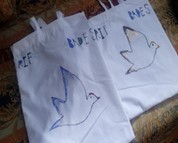Design Thinking
Students building sustainable solutions
A new life for plastic waste
In the little village of Bades near the Moroccan Mediterranean coast, Fatima knows that plastic washed up on the beach sometimes ends up in the stomachs of the chickens she prepares for her family. The teacher running the “Ressacs sans plastiques” project (Rahmani et al., submitted) also told her that many marine animals get sick from eating plastic. Fatima, a member of a local crafts cooperative, spent a lot of time looking for solutions to this problem. It was very challenging because her cooperative had decided to reuse plastic waste to make marketable products. Fatima thought of stuffing toys with bits of plastic. She posted a photo of her first bird toy prototype on the “Ressacs” project Facebook group page for a quick product assessment. Fatima’s prototype was inspired by the fabric jewelry stuffed with plastic bags one of her friends made.



Other women made reusable bags to package the cooperative’s products. Plastic plates covered with fabric and embroidery were also proposed as possible solutions. Finally, the cooperative made multiple trips to the beach to remove plastic waste coming from the village, the river, and ocean currents. Efforts to resolve the plastic problem, which are ongoing in Bades, will end when the prototypes for replacing and reusing plastic have been evaluated and refined to meet the challenge raised by the women of Bades: How can we reduce the amount of plastic on our beach and at the same time develop new marketable products?
Design thinking: A means of cultivating core competencies
The problem-solving approach used by the young artisans in the “Ressacs sans plastiques” project is called design thinking. This term, popularized by California design and innovation firm IDEO in 2006, describes a creative, collaborative work process that generates multiple solutions, rapidly prototypes and tests, and focuses on users’ needs. Initially employed to create commercial products, design thinking is now used by organizations (e.g. IDEO.org and d.school, in the United States) and schools (Design for Change, in India) to develop solutions for improving quality of life and the environment. Whether applied in the sciences, humanities or environmental education, design thinking offers the opportunity to analyze local problems and find solutions that foster sustainable development goals (UNESCO, 1995): creating sustainable communities (Goal 11), fighting climate change (Goal 13), and protecting land-based ecosystems (Goal 15). Moreover, since the design thinking process is both relevant and meaningful, it supports the acquisition of numerous core competencies: critical thinking, problem solving, innovation, creativity, etc.
For example, young students working with the Design for Change organization built remote-control planes out of recyclable materials to carry and disperse seeds for revegetating land adjacent to their school. Other students, also inspired by Design for Change, installed a special ramp so students with disabilities could board the school bus instead of relying on adapted transportation, enabling these children to take part in class field trips and enjoy opportunities to socialize on the bus. The Design for Change philosophy is based on the premise, “I can!”
Stages in the design thinking process
Design thinking is a non-linear, iterative process involving defined stages that can be carried out sequentially, simultaneously, out of order or even repeated. The ultimate goal is to bring about transformative change. The steps presented below (see Figure 1) were inspired primarily by Brown (2009) and Scheer, Noweski and Meinel (2012).

Figure 1: Steps of Design Thinking
Inspired by Brown (2009) and Scheer, Noweski and Meinel (2012)
- Observe-empathize: Conduct an ethnographic survey to understand the problem situation, and empathize with the people involved (users). Observe users as they go about their daily lives to gain insight into their aspirations and unmet needs (pain points).
- Define-synthesize: Define the problem multiple times. Look for information and a variety of perspectives on the problem. Synthesize this information to describe the conceptual challenge in several problem statements, often with the help of visual aids. A visual representation helps problem solvers come together and focus on their common goal (the conceptual challenge).
- Ideate: Generate numerous ideas and then select some for development.
- Prototype: Quickly build prototypes illustrating the ideas selected so they can be shared with and tested by others.
- Test: Evaluate the prototypes by collecting feedback from users and experts. Refine the best prototypes.
- Communicate: Promote the product.
A human-centred approach
An iterative approach focused on the needs of users, design thinking is also practical and flexible when it comes to experimentation. Both divergent and convergent, the process values empathy and optimism. Design thinking is non-linear because as problem solvers gain empathy for the needs of users and work on refining the best solution, their attention constantly shifts between the problem space and the solution space. Unlike a traditional scientific investigative approach, design thinking focuses on both the problem and its solutions. In the problem space, a lot of attention is paid to defining the problem in terms of the user experience and position. The team of problem solvers spends a lot of time observing the problem situation and user behaviours in situ. The effectiveness of the process relies on participants amassing and deepening their knowledge about the problem. In the solution space, problem solvers investigate multiple possibilities by developing plans and building prototypes. These prototypes, created quickly, without trying to achieve perfection, serve as “playgrounds” for discussing and exploring various solutions. In this fashion, the problem and its solutions co-evolve, constantly interacting.
Learning about sustainable development in the classroom
Design thinking has recently been presented as an effective, motivating tool for teaching elementary and high-school students how to solve local problems. To address local ecological issues, students could use this approach to create or organize:
- shelters for small wildlife (hares, ruffed grouse, amphibians, oysters, fish) designed to meet their needs for food and protection
- tasty menus of meatless meals
- tools for collecting rainwater
- bird baths
- hotels for useful insects: ladybugs, mason bees (solitary wasps)
- adaptation measures for climate change events like floods, droughts, erosion, heavy rains
- mini-preserves to promote biodiversity in urban settings
- toys to encourage their friends to play outside
- ways to express affection to friends and family while maintaining the social distancing recommended under COVID-19
- techniques for greening riparian buffers, etc. (Pruneau et al., 2019)
By using design thinking, teachers and their students can help achieve the Sustainable Development Goals (SGDs) defined by the United Nations in 2015. The 17 goals in question focus on areas for action that promote, for example, sustaining life (both human and nonhuman), ending poverty, and achieving social justice. In the case of the aforementioned “Ressacs sans plastiques” project, the artisans’ work focused primarily on goal 14: Conserve and sustainably use the oceans, seas, and marine resources. The examples suggested above for elementary and high-school students would include the following SGDs: 3 (health), 6 (water quality), 11 (resilient, healthy cities), 12 (environmentally responsible behaviour), 13 (climate change), and 15 (land-based ecosystems).
The meaning and nature of sustainable development and the actions required to achieve it are starting to become known. Emerging sustainability initiatives include the slow food movement (Petrini, 2006), conservation design (Arendt, 2010), smart growth (Duany et al., 2010), eco-cities (Register, 2016), and biodiversity restoration (El Jai & Pruneau, 2015). Slow food aficionados take the time to share locally grown “clean” food with people in their community. In conservation design, urban planners developing new neighbourhoods begin by identifying sites of natural and cultural interest, then concentrate the built environment outside the areas where these treasures are found. Proponents of smart growth and eco-cities use a variety of techniques to reuse rainwater, calm traffic, increase the density of residential areas, and promote universal access to parks. Finally, efforts to restore biodiversity include measures such as wildlife crossings, living plant walls, green roofs, hedgerows for biodiversity, and hotels for insects, amphibians and small mammals. Over time, these sustainability initiatives modify existing systems, structures and practices, with the ultimate goal of regenerating natural systems that support human life and that of other living beings.
With design thinking, students can work with their classmates to contribute their own ideas to the sustainability movement. This investigative approach is well suited for the complex nature of environmental problems. Design thinking fosters more appropriate solutions because it invites students to define complex problems from different perspectives (social, scientific and environmental), which enables them to expand the problem space before looking for solutions. According to our field tests, design thinking can encourage students to work collaboratively, pique their interest in the problem under study, and strengthen their high-level skills like creativity, empathy, critical thinking and problem solving (Pruneau et al., 2019). The iterative design thinking process encourages learners to ask questions, look for information, collaborate with their peers and the community, propose concrete ideas, and test and model solutions, all while focusing on the needs of users. Engaging in this dynamic process develops their sustainability skills.
When solutions generated by design thinking become realities, learners gain confidence in their capacity for action. Moreover, organizations that employ design thinking also mentioned other educational benefits, especially with regards to teamwork: richer discussions thanks to a diverse group of problem solvers, enhanced communications, a shared understanding of the vocabulary used, and greater cohesion (Pruneau et al., 2019).
Banner Photo: Adobe Stock
Photos provided by the authors
First published in Education Canada, March 2021
Read other articles from this issue
References
Arendt, R. (2010). Envisioning better communities. Seeing more options, making wiser choices. Routledge.
Brown, T. (2009). Change by design: How design thinking transforms organizations and inspires innovation. Harper Collins.
Duany, A., Speck, J. & Lydon, M. (2010). The smart growth manual. McGraw-Hill.
El Jai, B. & Pruneau, D. (2015). Favoriser la restauration de la biodiversité en milieu urbain : les facteurs de réussite dans le cadre de quatre projets de restauration. VertigO, 15(3).
Petrini, C. (2006). Slow Food, manifeste pour le goût et la biodiversité. Yves Michel.
Pruneau, D. (ed.). (2019). Design thinking for sustainable development. Applied models for schools, universities and communities. Université de Moncton, Groupe Littoral et vie. Available free of charge online in French and English: https://competi.ca/ and https://lel.crires.ulaval.ca/categorie/guidesoutils-pedagogiques.
Rahmani, Z., Pruneau, D. & Khattabi, A. (submitted). La pensée design et Facebook comme outils pédagogiques pour accompagner des femmes dans la résolution d’un problème de pollution plastique au Maroc. VertigO.
Register, R. (2016). World rescue: An economics built on what we build. Ecocity Builders.
Scheer, A., Noweski, C. &Meinel, C. (2012). Transforming constructivist learning into action: Design thinking in education. Design and Technology Education: An International Journal, 17(3).
1 Abdellatif Khattabi, Zakia Rahmani, Michel Léger, Boutaina El Jai, Liliane Dionne, Vincent Richard, Viktor Freiman, Natacha Louis, Anne-Marie Laroche, and Maroua Mahjoub
